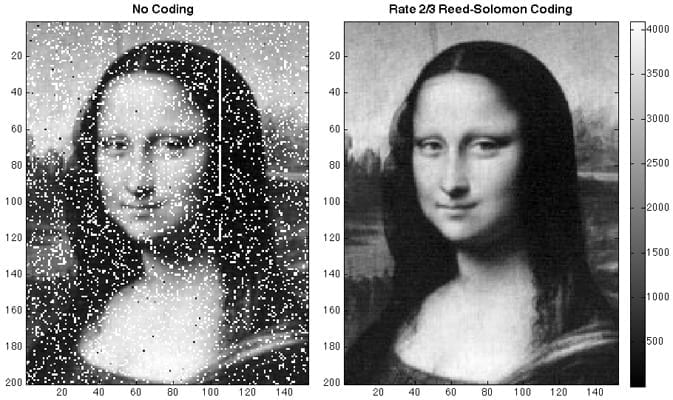
“This is the first time anyone has achieved one-way laser communication at planetary distances,”
As part of the first demonstration of laser communication with a satellite at the moon, scientists with NASA’s Lunar Reconnaissance Orbiter (LRO) beamed an image of the Mona Lisa to the spacecraft from Earth.
The iconic image traveled nearly 240,000 miles in digital form from the Next Generation Satellite Laser Ranging (NGSLR) station at NASA’s Goddard Space Flight Center in Greenbelt, Md., to the Lunar Orbiter Laser Altimeter (LOLA) instrument on the spacecraft. By transmitting the image piggyback on laser pulses that are routinely sent to track LOLA’s position, the team achieved simultaneous laser communication and tracking.
“This is the first time anyone has achieved one-way laser communication at planetary distances,” says LOLA’s principal investigator, David Smith of the Massachusetts Institute of Technology. “In the near future, this type of simple laser communication might serve as a backup for the radio communication that satellites use. In the more distant future, it may allow communication at higher data rates than present radio links can provide.”
Typically, satellites that go beyond Earth orbit use radio waves for tracking and communication. LRO is the only satellite in orbit around a body other than Earth to be tracked by laser as well.
“Because LRO is already set up to receive laser signals through the LOLA instrument, we had a unique opportunity to demonstrate one-way laser communication with a distant satellite,” says Xiaoli Sun, a LOLA scientist at NASA Goddard and lead author of the Optics Express paper, posted online today, that describes the work.
Precise timing was the key to transmitting the image. Sun and colleagues divided the Mona Lisa image into an array of 152 pixels by 200 pixels. Every pixel was converted into a shade of gray, represented by a number between zero and 4,095. Each pixel was transmitted by a laser pulse, with the pulse being fired in one of 4,096 possible time slots during a brief time window allotted for laser tracking. The complete image was transmitted at a data rate of about 300 bits per second.
The laser pulses were received by LRO’s LOLA instrument, which reconstructed the image based on the arrival times of the laser pulses from Earth. This was accomplished without interfering with LOLA’s primary task of mapping the moon’s elevation and terrain and NGSLR’s primary task of tracking LRO.
The success of the laser transmission was verified by returning the image to Earth using the spacecraft’s radio telemetry system.
Turbulence in Earth’s atmosphere introduced transmission errors even when the sky was clear. To overcome these effects, Sun and colleagues employed Reed-Solomon coding, which is the same type of error-correction code commonly used in CDs and DVDs. The experiments also provided statistics on the signal fluctuations due to Earth’s atmosphere.
via NASA/Goddard Space Flight Center
The Latest Streaming News: Laser communication updated minute-by-minute
Bookmark this page and come back often
Latest NEWS
Latest VIDEO








